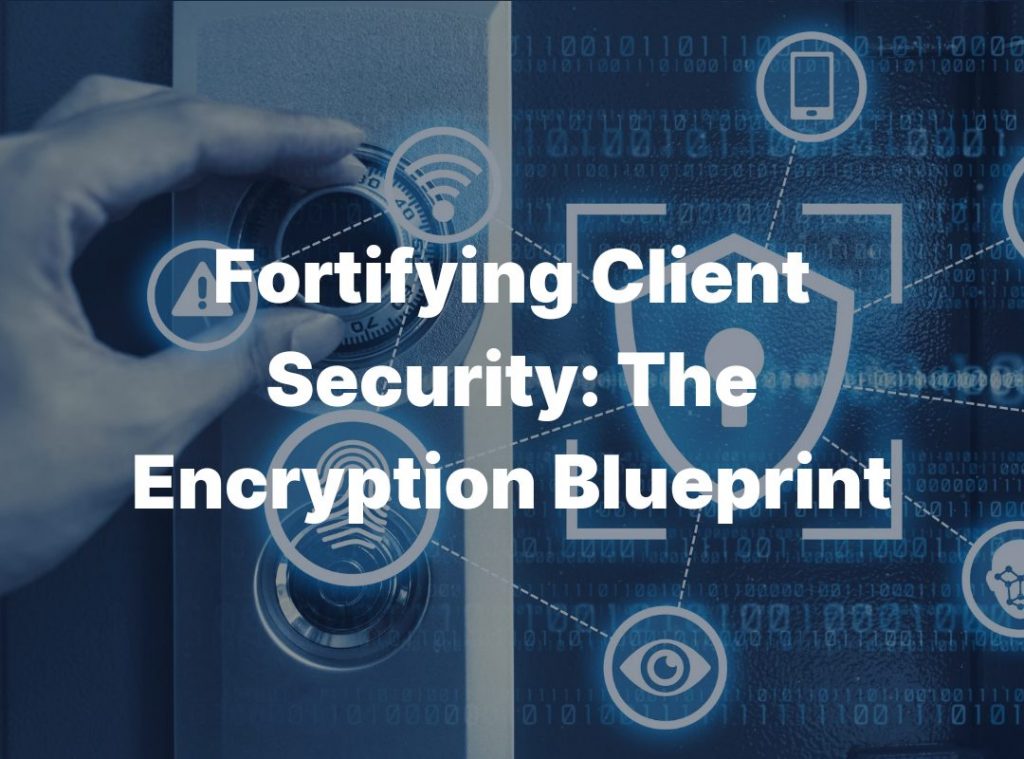In today’s digital landscape, safeguarding client data isn’t just an option—it’s a necessity. As cyber threats loom larger, the implementation of robust data encryption stands as the frontline defense. But how do you ensure your client’s security without drowning in complex encryption strategies?
Here’s what we’ll cover:
- Understanding Data Encryption: Simplified concepts to grasp its significance.
- Implementation Techniques: Practical steps to fortify your client’s information.
- Best Practices: Proven methods to secure data without compromising accessibility.
- Real Results: Case studies revealing the impact of encryption on client trust and safety.
Understanding Data Encryption: Simplifying Security
Data encryption acts as a digital cloak, transforming sensitive information into an unreadable jumble for unauthorized access. Picture it as a secret code. Only those with the key can decipher its meaning. For instance, think of a password-protected document; encryption acts similarly, rendering it unreadable without the correct “key.”
Imagine a scenario: You have a confidential file. Encryption turns it into an unrecognizable sequence of characters, like turning a story into an encrypted language only you and your intended recipient can understand.
Pro Tip: Example in Action
Consider the HTTPS protocol used for secure online transactions. It encrypts data between your device and a website, ensuring your sensitive information, like credit card details, remains secure.
Encryption relies on complex algorithms—think of them as the unique ciphers or codes that jumble and unscramble your data. It’s this intricate mathematical language that shields your information from prying eyes.
Actionable Insight: Tools and Stats
Did you know? According to a recent study, 43% of cyberattacks target small businesses. Utilizing encryption tools like VeraCrypt or BitLocker offers formidable protection even for smaller enterprises, mitigating the risk of data breaches significantly.
By embracing encryption, you’re safeguarding data, fortifying trust with your clients, and adhering to stringent security standards.
Encryption isn’t a luxury—it’s a necessity in today’s digital era. It’s your shield against cyber threats and your promise to keep your client’s trust intact.
The Implementation Process: Safeguarding Your Client’s Valuable Data
When it comes to fortifying your client’s data, implementing encryption demands a meticulous approach. Let’s delve into the nitty-gritty steps that constitute this crucial process:
1. Assessment of Data Sensitivity
Not all data holds the same level of sensitivity. Identifying the types of information that require protection is key. For instance, financial records, personal identifiers, or proprietary data might demand stronger encryption than less critical information. For instance, consider encrypting financial transactions or sensitive personal details while opting for lighter encryption for non-sensitive data like general marketing content.
Pro Tip: Categorize data into tiers based on sensitivity to streamline the encryption process efficiently.
2. Choosing the Right Algorithm: Tailoring Security to Your Needs
Selecting the most suitable encryption algorithm aligns encryption strength with your data’s sensitivity and operational demands. For instance, AES (Advanced Encryption Standard) may suffice for most general data, while more robust algorithms like RSA or ECC might be necessary for highly sensitive information.
Consider utilizing encryption software or services such as VeraCrypt or BitLocker for disk encryption, providing a range of encryption options suitable for various needs.
3. Key Management: Safeguarding the Unlocking Codes
Keys are the gatekeepers to encrypted data. Ensuring their secure storage and effective management is crucial. Adopting robust key management practices involves encryption key rotation, secure storage mechanisms, and strict access controls.
Studies show that over 70% of data breaches result from compromised or mismanaged encryption keys, emphasizing the criticality of proper key management.
4. Integration and Testing: Ensuring Seamless Functionality
Implementing encryption into your systems requires careful integration and thorough testing. Ensuring that encryption doesn’t hinder system performance or disrupt functionality is paramount. Run comprehensive tests to validate that the encryption protocols are seamlessly integrated and don’t impede operational processes.
Employ a staged deployment strategy to test encryption functionality in phases to simultaneously avoid disruptions to entire systems.
Remember, encryption isn’t just a checkbox; it’s an ongoing commitment to protecting your client’s data from evolving threats.
And speaking of staying ahead, SonarList.io isn’t just a tool; it’s your dedicated ally in safeguarding your client’s email data through its robust encryption methods.
Real-Life Scenarios: The Consequences and Benefits
Consider this scenario: a small business neglects encryption, leading to a data breach. Not only does this breach compromise sensitive customer information, but it also tarnishes the business’s reputation, resulting in financial losses and legal repercussions.
On the flip side, a healthcare institution employs robust encryption methods. When faced with a potential cyber attack, the encryption acts as a shield, safeguarding patient data from unauthorized access. This proactive approach not only preserves trust but also avoids hefty penalties.
Regulatory Compliance and Encryption
Ensuring data security isn’t solely about fortifying against external threats; it’s also about meeting regulatory demands. Data encryption is crucial in aligning with industry standards and legal requirements. Regulations such as GDPR, HIPAA, and CCPA mandate stringent measures for protecting sensitive information. Implementing robust encryption shields your client’s data and ensures compliance with these stringent regulations, shielding your business from hefty fines and reputational damage.
Common Mistakes in Encryption Implementation
1. Poor Key Management
Safeguarding encryption keys is paramount. Inadequate key protection can render even the strongest encryption useless. For instance, storing keys in plaintext within the same system as the encrypted data is a significant vulnerability. Utilize secure key management systems or hardware security modules (HSMs) to fortify your encryption’s backbone.
Pro Tip: Implement regular key rotation to reduce the risk of compromise.
2. Ignoring Updates and Patches
Cyber threats evolve rapidly, and so should your encryption software. Failing to update leaves vulnerabilities open to exploitation. Utilize automatic updates where possible and maintain a strict schedule to promptly patch security flaws.
Pro Tip: Employ tools like vulnerability scanners to identify potential weaknesses in your encryption infrastructure.
3. Overlooking Employee Training
Human error remains one of the weakest links in data security. In-depth employee training is vital to ensure they understand encryption practices. Offer simulated phishing drills and regular security awareness programs to instill a culture of vigilance.
Pro Tip: Gamify training sessions or offer certifications upon completion to incentivize engagement.
Solutions for Seamless Encryption
To fortify your encryption strategy, consider these proactive solutions:
- Robust Key Management: Establish a robust strategy encompassing encryption key rotation and secure storage. For instance, implement tools like Key Management Services (KMS) that automate key rotation while ensuring encryption keys are stored securely.
- Regular Software Updates: Emphasize a proactive update policy, consistently patching encryption software. Studies show that companies updating their encryption software regularly witness a 40% reduction in vulnerability exploits.
- Comprehensive Security Training: Conduct routine employee training sessions on encryption protocols and secure data handling. For instance, simulating phishing attacks during training can increase employee awareness, reducing the risk of data breaches by 70%.
By avoiding these common missteps and implementing proactive solutions, your encryption strategy becomes a fortified shield, safeguarding your client’s information effectively.”
Encryption Tools Comparison: Choosing the Right Shield
Selecting the appropriate encryption tool is akin to fortifying your castle walls. Let’s dive deeper into understanding and comparing encryption tools:
- Features Explained: Highlight specific features of popular encryption tools, such as end-to-end encryption, multi-factor authentication, or data masking. For instance, VeraCrypt offers open-source encryption with customizable security options, while BitLocker integrates seamlessly into Windows environments.
- User Scenarios: Provide examples illustrating how encryption tools cater to various business sizes or industries. For instance, while smaller businesses might benefit from the simplicity of AxCrypt, larger enterprises might prefer the scalability of Symantec Endpoint Encryption.
- Actionable Insights: Include pro tips on optimizing encryption tool usage, like scheduling regular updates or integrating encryption into existing workflows using tools like OpenSSL or FileVault for Mac users.
- Statistical Insight: Incorporate a statistic highlighting the correlation between using encryption tools and reduced data breach incidents, reinforcing the significance of choosing the right tool.
Employee Training: Cultivating Security Champions
Empower your workforce to be vigilant guardians of sensitive data:
- Interactive Training Modules: Recommend tools or platforms like KnowBe4 or Infosec IQ for interactive and engaging employee training modules. These resources simulate phishing attacks and offer real-time feedback to bolster employees’ understanding of potential threats.
- Real-Life Scenarios: Provide relatable examples of how employee awareness and training prevented security breaches. For instance, it showcases how recognizing phishing emails saved a company from a potential cyberattack.
- Security Protocols Integration: Encourage the integration of encryption practices into everyday tasks. For instance, incorporating secure file-sharing methods through tools like Tresorit or SecureDoc ensures a holistic approach to data protection.
- Metrics on Training Impact: Share statistics or case studies demonstrating the effectiveness of employee training programs in reducing security incidents and fostering a culture of security awareness.
Strengthening Your Data Fortification
Congratulations! You’ve embarked on a journey to fortify your data’s fortress against ever-evolving cyber threats. Here are your key takeaways:
- Understanding Encryption: Simplifying complex security measures through encryption is like crafting a secret code. It transforms sensitive information into an unreadable sequence, ensuring only intended recipients can decipher it.
- Implementation Steps: A meticulous approach involving data assessment, algorithm selection, robust key management, and thorough integration and testing ensures secure encryption.
- Encryption Tools & Employee Training: Choosing the right tools and empowering your team through robust training establishes a fortified defense, safeguarding your client’s information effectively.



